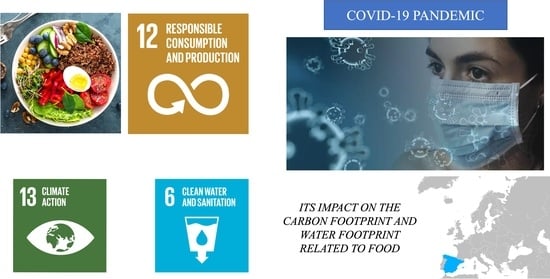Climate Change and Water Scarcity at the Focus of Environmental Impacts Associated with the COVID-19 Crisis in Spain
Abstract
1. Introduction
2. Materials and Methods
2.1. Food Consumption Data
2.2. Data Analysis
2.3. Carbon Footprint
- (i)
- Agriculture and industrial food production (S1): This first stage encompasses the production of the foods that make up each dietary scenario.
- (ii)
- Wholesale and retail distribution stage (S2): This second stage comprises the flow of food items from manufacturer to wholesaler and retailer.
- (iii)
- Household consumption stage (S3): This last part of the value chain includes the distribution of food items from retailers to households.
2.4. Water Footprint
3. Results
3.1. Composition of the Spanish Average Dietary Pattern during the COVID-19 Pandemic (2020)
3.2. Carbon Footprint Analysis for the Spanish Dietary Pattern during the COVID-19 Pandemic (2020)
3.3. Water Footprint Analysis for the Spanish Dietary Pattern during the COVID-19 Pandemic (2020)
3.4. Month-to-Month Analysis of the Spanish Food Consumption Patterns and Its Impacts on the Environment during 2020
3.5. Comparison of the Carbon Footprint and Water Footprint of the Dietary Pattern in Spain with 2019 as the Baseline Year
3.5.1. Carbon Footprint
3.5.2. Water Footprint
4. Discussion
4.1. Comparison with Other International Studies
4.2. Policy Implications
4.3. Strengths and Weaknesses of the Study
5. Conclusions
Supplementary Materials
Author Contributions
Funding
Institutional Review Board Statement
Informed Consent Statement
Data Availability Statement
Acknowledgments
Conflicts of Interest
References
- WHO. Coronavirus Disease (COVID-19) Pandemic. World Health Organization [WWW Document]. 2019. Available online: https://www.euro.who.int/en/health-topics/health-emergencies/coronavirus-covid-19/novel-coronavirus-2019-ncov (accessed on 2 October 2022).
- WHO. WHO Coronavirus Disease (COVID-19). Dashboards; World Health Organization: Geneva, Switzerland, 2020. [Google Scholar]
- Rajan, S.; McKee MHernández-Quevedo CKaranikolos, M.; Richardson, E.; Webb, E.; Cylus, J. What have European countries done to prevent the spread of COVID-19? Lessons from the COVID-19 Health System Response Monitor. Health Policy 2022, 126, 355–361. [Google Scholar] [CrossRef]
- BOE. Real Decreto 463/2020, de 14 de Marzo, por el que se Declara el Estado de Alarma para la Gestión de la Situación de Crisis Sanitaria Ocasionada por el COVID-19. 2020. Boletín Oficial del Estado, 67, de 14/03/2020. Available online: https://www.boe.es/buscar/act.php?id=BOE-A-2020-3692 (accessed on 19 October 2022).
- Brooks, S.K.; Webster, R.K.; Smith, L.E.; Woodland, L.; Wessely, S.; Greenberg, N.; Rubin, G.J. The psychological impact of quarantine and how to reduce it: Rapid review of the evidence. Lancet 2020, 395, 912–920. [Google Scholar] [CrossRef] [PubMed]
- Fawaz, M.; Samaha, A. COVID-19 quarantine: Post-traumatic stress symptomatology among Lebanese citizens. Int. J. Soc. Psychiatry 2020, 66, 666–674. [Google Scholar] [CrossRef]
- Imperial College of London. Food and Coronavirus. Examining the Pandemic’s Impact on the Diet [WWW Document]. 2020. Available online: https://www.imperial.ac.uk/stories/food-and-coronavirus/ (accessed on 21 November 2022).
- Eftimov, T.; Popovski, G.; Petković, M.; Seljak, B.K.; Kocev, D. COVID-19 pandemic changes the food consumption patterns. Trends Food Sci. Technol. 2020, 104, 268–272. [Google Scholar] [CrossRef]
- Navarro-Pérez, C.F.; Fernández-Aparicio, Á.; González-Jiménez, E.; Montero-Alonso, M.Á.; Schmidt-RioValle, J. Effects of COVID-19 lockdown on the dietary habits and lifestyle in a population in southern Spain: A cross-sectional questionnaire. Eur. J. Clin. Nutr. 2021, 76, 883–890. [Google Scholar] [CrossRef]
- WHO. Food and Nutrition Tips during Self-Quarantine [WWW Document]. 2019. Available online: https://www.euro.who.int/en/health-topics/health-emergencies/coronavirus-covid-19/publications-and-technical-guidance/food-and-nutrition-tips-during-self-quarantine (accessed on 28 November 2022).
- WHO. Coronavirus Disease (COVID-19): Staying Active. World Health Organization [WWW Document]. 2020. Available online: https://www.who.int/emergencies/diseases/novel-coronavirus-2019/question-and-answers-hub/q-a-detail/coronavirus-disease-covid-19-staying-active (accessed on 2 December 2022).
- Ammar, A.; Brach, M.; Trabelsi, K.; Chtourou, H.; Boukhris, O.; Masmoudi, L.; Bouaziz, B.; Bentlage, E.; How, D.; Ahmed, M.; et al. Effects of COVID-19 Home Confinement on Eating Behaviour and Physical Activity: Results of the ECLB-COVID19 International Online Survey. Nutrients 2020, 12, 1583. [Google Scholar] [CrossRef] [PubMed]
- Brown, A.; Flint, S.W.; Kalea, A.Z.; O’Kane, M.; Williams, S.; Batterham, R.L. Negative impact of the first COVID-19 lockdown upon health-related behaviours and psychological wellbeing in people living with severe and complex obesity in the UK. EClinicalMedicine 2021, 34, 100796. [Google Scholar] [CrossRef] [PubMed]
- European Commission. Emissions Changes Due to Lockdown Measures during the First Wave of the COVID-19 Pandemic in Europe; European Commission: Brussels, Belgium, 2020. [Google Scholar]
- UN. Sustainable Development Goals. 2021. Available online: http://sustainabledevelopment.un.org/?menu=1300 (accessed on 2 October 2021).
- Crippa, M.; Solazzo, E.; Guizzardi, D.; Monforti-Ferrario, F.; Tubiello, F.N.; Leip, A.J.N. Food systems are responsible for a third of global anthropogenic GHG emissions. Nat. Food 2021, 2, 198–209. [Google Scholar] [CrossRef]
- Xiong, X.; Zhang, L.; Hao, Y.; Zhang, P.; Chang, Y.; Liu, G. Urban dietary changes and linked carbon footprint in China: A case study of Beijing. J. Environ. Manag. 2020, 255, 109877. [Google Scholar] [CrossRef]
- Zucchinelli, M.; Spinelli, R.; Corrado, S.; Lamastra, L. Evaluation of the influence on water consumption and water scarcity of different healthy diet scenarios. J. Environ. Manag. 2021, 291, 112687. [Google Scholar] [CrossRef]
- Clark, M.A.; Springmann, M.; Hill, J.; Tilman, D. Multiple health and environmental impacts of foods. Proc. Natl. Acad. Sci. USA 2019, 116, 23357–23362. [Google Scholar] [CrossRef] [PubMed]
- MAPA. Spanish Ministry of Agriculture, Food and Environment. 2019. Available online: https://www.mapa.gob.es/app/consumo-en-hogares/consulta.asp (accessed on 1 August 2022).
- MAPA. Spanish Ministry of Agriculture, Food and Environment. 2020. Available online: https://www.mapa.gob.es/app/consumo-en-hogares/consulta11.asp (accessed on 2 August 2022).
- Ministerio de Agricultura Pesca y Alimentación. 2020. Informe del Consumo de Alimentación en España 2019. Minist. Agric. Pesca y Aliment. 674. Available online: https://www.mapa.gob.es/en/alimentacion/temas/consumo-tendencias/informe2019_v2_tcm38-540250.pdf (accessed on 20 July 2022).
- González-García, S.; Green, R.F.; Scheelbeek, P.F.; Harris, F.; Dangour, A.D. Dietary recommendations in Spain –affordability and environmental sustainability? J. Clean. Prod. 2020, 254, 120125. [Google Scholar] [CrossRef] [PubMed]
- Cambeses-Franco, C.; González-García, S.; Feijoo, G.; Moreira, M.T. Is the paleo diet safe for health and the environment? Sci. Total Environ. 2021, 781, 146717. [Google Scholar] [CrossRef]
- Kovacs, B.; Miller, L.; Heller, M.C.; Rose, D. The carbon footprint of dietary guidelines around the world: A seven country modeling study. Nutr. J. 2021, 20, 15. [Google Scholar] [CrossRef]
- ISO 14040:2006; Environmental Management-Life Cycle Assessment. International Organization for Standarization. ISO: Geneva, Switzerland, 2006.
- Ministerio de Economia. DATACOMEX. Base de Datos Multidimensionales de Comercio Exterior de Mercancías Español. 2019. Available online: https://comercio.serviciosmin.gob.es/Datacomex/ (accessed on 20 July 2022).
- Castañé, S.; Antón, A. Assessment of the nutritional quality and environmental impact of two food diets: A Mediterranean and a vegan diet. J. Clean. Prod. 2017, 167, 929–937. [Google Scholar] [CrossRef]
- Batlle-Bayer, L.; Bala, A.; García-Herrero, I.; Lemaire, E.; Song, G.; Aldaco, R.; Fullana-i-Palmer, P. The Spanish Dietary Guidelines: A potential tool to reduce greenhouse gas emissions of current dietary patterns. J. Clean. Prod. 2019, 213, 588–598. [Google Scholar] [CrossRef]
- Garcia-Herrero, I.; Hoehn, D.; Margallo, M.; Laso, J.; Bala, A.; Batlle-Bayer, L.; Fullana, P.; Vazquez-Rowe, I.; Gonzalez, M.J.; Durá, M.; et al. On the estimation of potential food waste reduction to support sustainable production and consumption policies. Food Policy 2018, 80, 24–38. [Google Scholar] [CrossRef]
- Gustavsson, J.; Cederberg, C.; Sonesson, U.; Emanuelsson, A. The Methodology of the FAO Study: “Global Food Losses and Food Waste-Extent, Causes and Prevention”-FAO, 2011, SIK Report No. 857; Food and Agriculture Organization of the United Nations: Düsseldorf, Germany, 2013. [Google Scholar]
- Harris, F.; Moss, C.; Joy, E.J.M.; Quinn, R.; Scheelbeek, P.F.D.; Dangour, A.D.; Green, R. The Water Footprint of Diets: A Global Systematic Review and Meta-analysis. Adv. Nutr. 2020, 11, 375–386. [Google Scholar] [CrossRef]
- Tickner, D.; Chapagain, A.K. Water Footprint Assessment: A Guide for Business; Routledge: London, UK, 2017. [Google Scholar] [CrossRef]
- Mekonnen, M.M.; Hoekstra, A. The Green, Blue and Grey Water Footprint of Farm Animals and Animal Products. Volume 1: Main Report. Unesco Value Water Res. Rep. Ser. No. 48; UNESCO-IHE Institute for Water Education: Enschede, The Netherlands, 2010. [Google Scholar]
- Mekonnen, M.M.; Hoekstra, A.Y. The green, blue and grey water footprint of crops and derived crop products. Hydrol. Earth Syst. Sci. 2011, 15, 1577–1600. [Google Scholar] [CrossRef]
- Blas, A.; Garrido, A.; Unver, O.; Willaarts, B. A comparison of the Mediterranean diet and current food consumption patterns in Spain from a nutritional and water perspective. Sci. Total Environ. 2019, 664, 1020–1029. [Google Scholar] [CrossRef]
- Harris, F.; Green, R.F.; Joy, E.J.M.; Kayatz, B.; Haines, A.; Dangour, A.D. The water use of Indian diets and socio-demographic factors related to dietary blue water footprint. Sci. Total Environ. 2017, 587, 128–136. [Google Scholar] [CrossRef] [PubMed]
- Pahlow, M.; van Oel, P.R.; Mekonnen, M.M.; Hoekstra, A.Y. Increasing pressure on freshwater resources due to terrestrial feed ingredients for aquaculture production. Sci. Total Environ. 2015, 536, 847–857. [Google Scholar] [CrossRef] [PubMed]
- Maestre, A.; Sospedra, I.; Mart, M.; Gutierrez-Hervas, A.; Hurtado-Saez, A.; Norte, A. Assessment of Spanish Food Consumption Patterns during COVID-19 Home Confinement. Nutrients 2021, 13, 4122. [Google Scholar] [CrossRef] [PubMed]
- Glicorić, K.; Chiolero, A.; Kiciman, E.; White, R.; West, R. Population-scale dietary interests during the COVID-19 pandemic. Nat. Commun. 2022, 13, 1073. [Google Scholar] [CrossRef]
- Bracale, R.; Vaccaro, C.M. Changes in food choice following restricive measure due to COVID-19. Nutr. Metab. Cardiovasc. Dis. 2020, 30, 1423–1426. [Google Scholar] [CrossRef] [PubMed]
- Lagula, L.; Fiszman, S.; Puerta, P.; Chaya, C.; Tárrega, A. The impact of COVID-19 lockdown on food priorities. Results from a preliminary study using social media and an online survey with Spanish consumers. Food Qual. Prefer. 2020, 86, 104028. [Google Scholar] [CrossRef]
- Marty, L.; de Lauzon-Guillain, B.; Labesse, M.; Nicklaus, S. Food choice motives and the nutritional quality of diet during the COVID-19 lockdown in France. Appetite 2021, 157, 105005. [Google Scholar] [CrossRef]
- Ruíz-Roso, M.B.; de Carvalho Padilha, P.; Matilla-Escalante, D.C.; Brun, P.; Ulloa, N.; Acevedo-Correa, D.; Arantes Ferreira Peres, W.; Martorell, M.; Rangel Bousquet Carrilho, T.; de Oliveira Cardoso, L.; et al. Changes of physicial activity and ultra-processed food consumption in adolescents from different countries during COVID-19 pandemic: An observational study. Nutrients 2020, 12, 2289. [Google Scholar] [CrossRef]
- Raza, T.; Shehzad, M.; Abbas, M.; Eash, N.S.; Jatav, H.S.; Sillanpaa, M.; Flynn, T. Impact assessment of COVID-19 global pandemic on water, environment, and humans. Environ. Adv. 2022, 11, 100328. [Google Scholar] [CrossRef]
- Batlle-Bayer, L.; Aldaco, R.; Bala, A.; Puig, R.; Laso, J.; Margallo, M.; Vázquez-Rowe, I.; Antó, J.M.; Fullana-i-Palmer, P. Environmental and nutritional impacts of dietary changes in Spain during COVID-19 lockdown. Sci. Total Environ. 2020, 748, 141410. [Google Scholar] [CrossRef]
- Marty, L.; de Lauzon-Guillain, B.; Nicklaus, S. Short- and Mid- term impacts of COVID-19 outbreak on the nutritional quality and environmental impact of diet. Front. Nutr. 2022, 9, 314. [Google Scholar] [CrossRef] [PubMed]
- Dangelico, R.M.; Schiaroli, V.; Fraccascia, L. Is COVID-19 changing sustainable consumer behaviour? A survey of Italian consumers. Sustain. Dev. 2022, 30, 1477–1496. [Google Scholar] [CrossRef]
- Cambeses-Franco, C.; González-García, S.; Feijoo, G.; Moreira, M.T. Driving commitment to sustainable food policies within the framework of American and European dietary guidelines. Sci. Total Environ. 2021, 807, 150894. [Google Scholar] [CrossRef] [PubMed]
- Esteve-Llorens, X.; Dias, A.C.; Moreira, M.T.; Feijoo, G.; González-García, S. Evaluating the Portuguese diet in the pursuit of a lower carbon and healthier consumption pattern. Clim. Chang. 2020, 162, 2397–2409. [Google Scholar] [CrossRef]
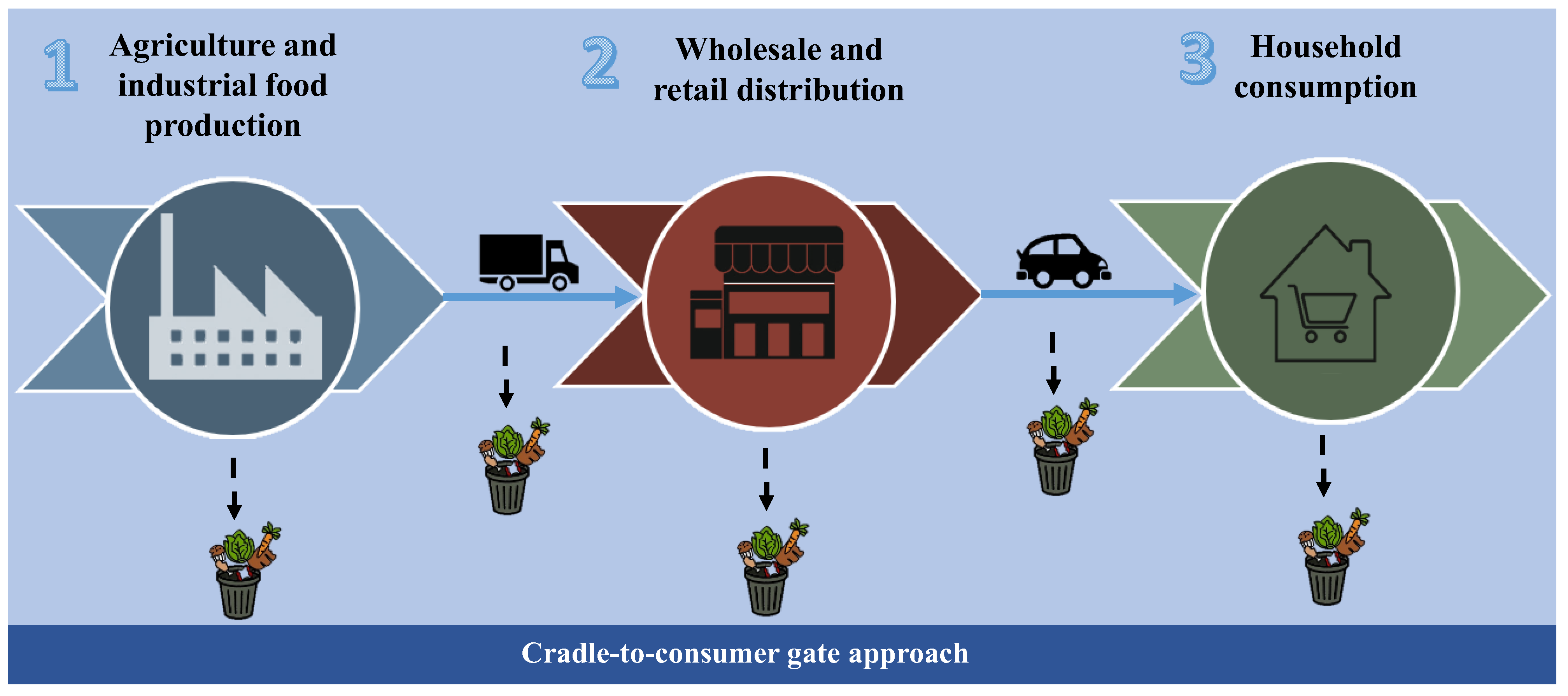
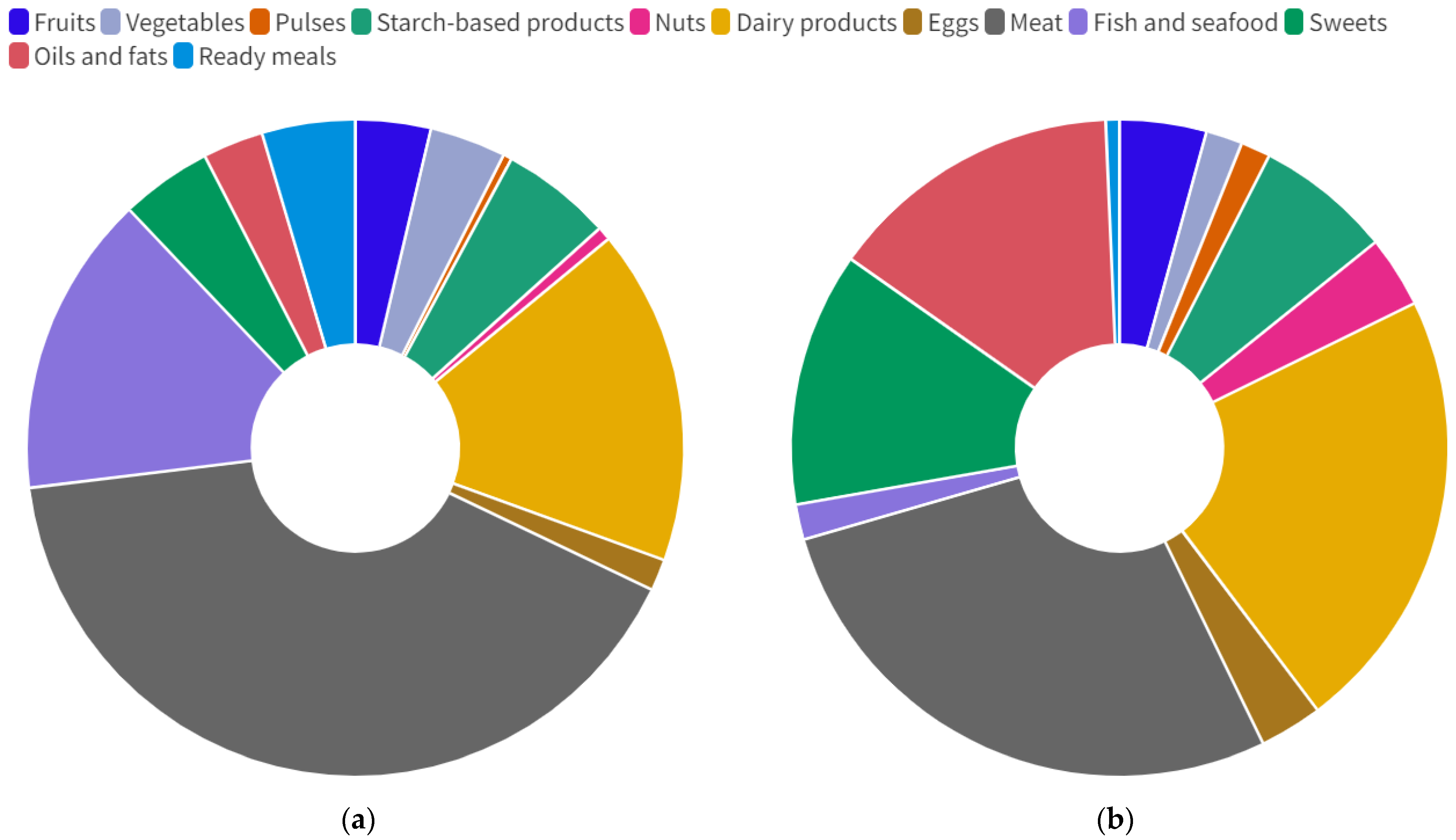
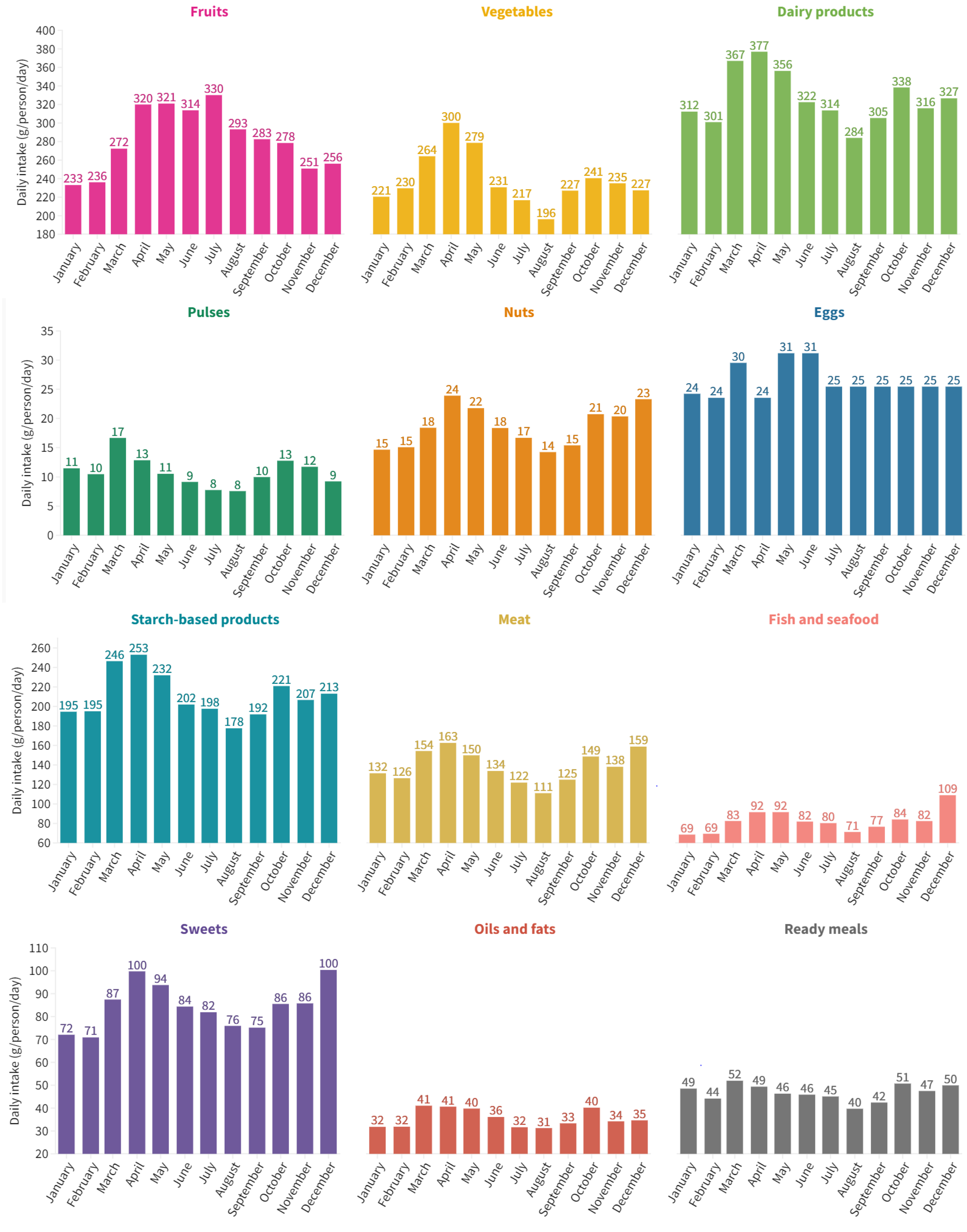
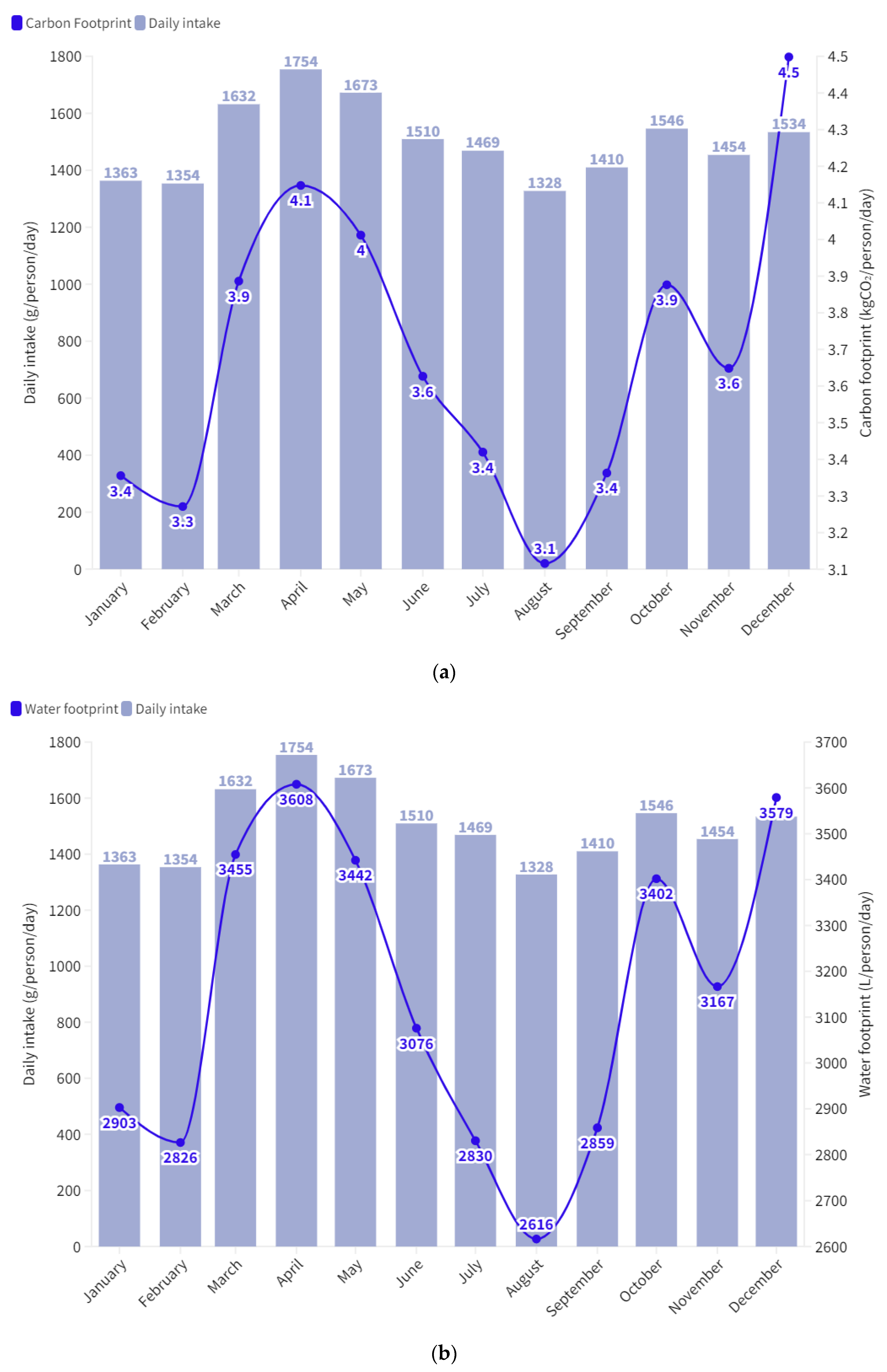
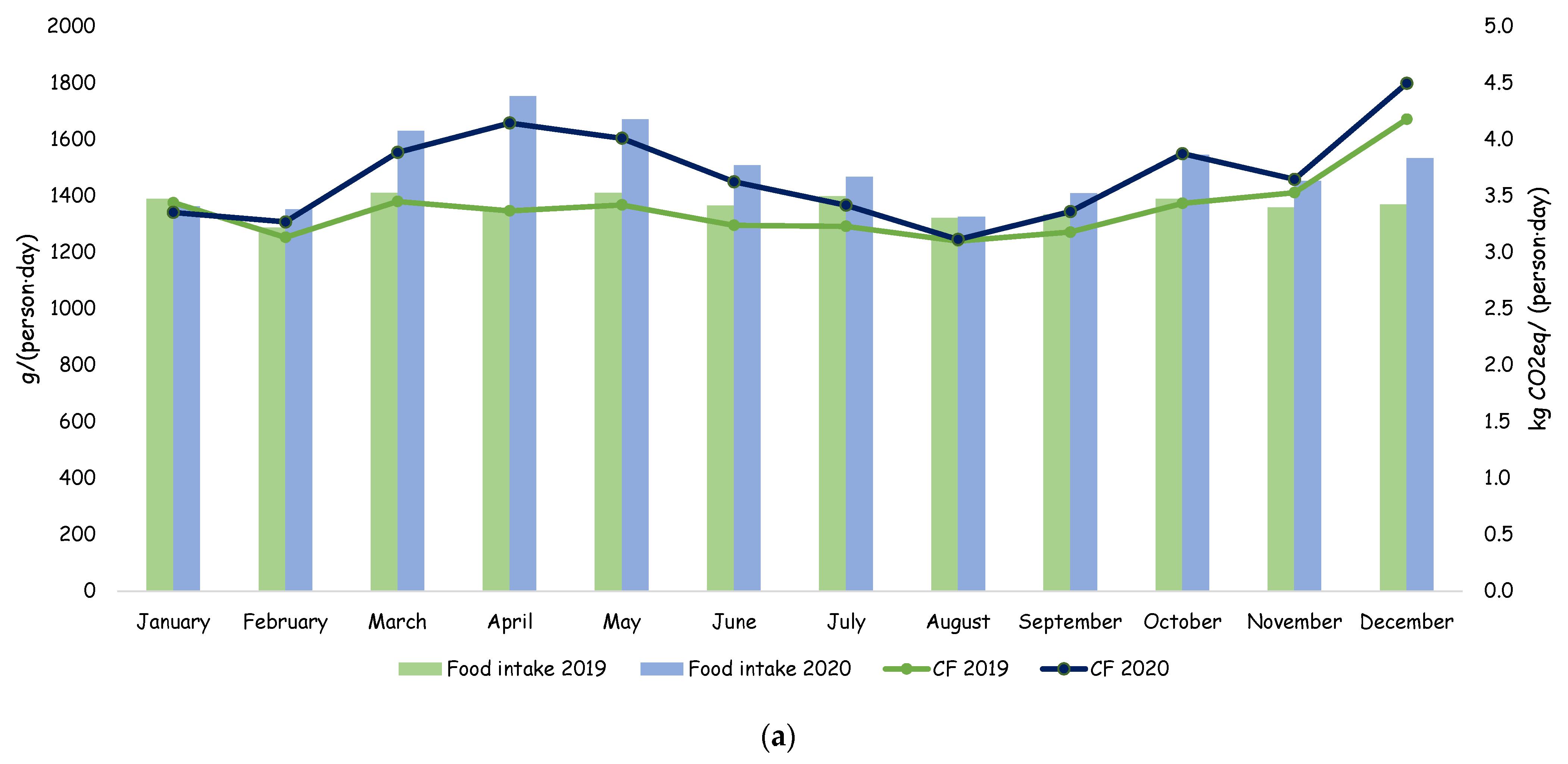
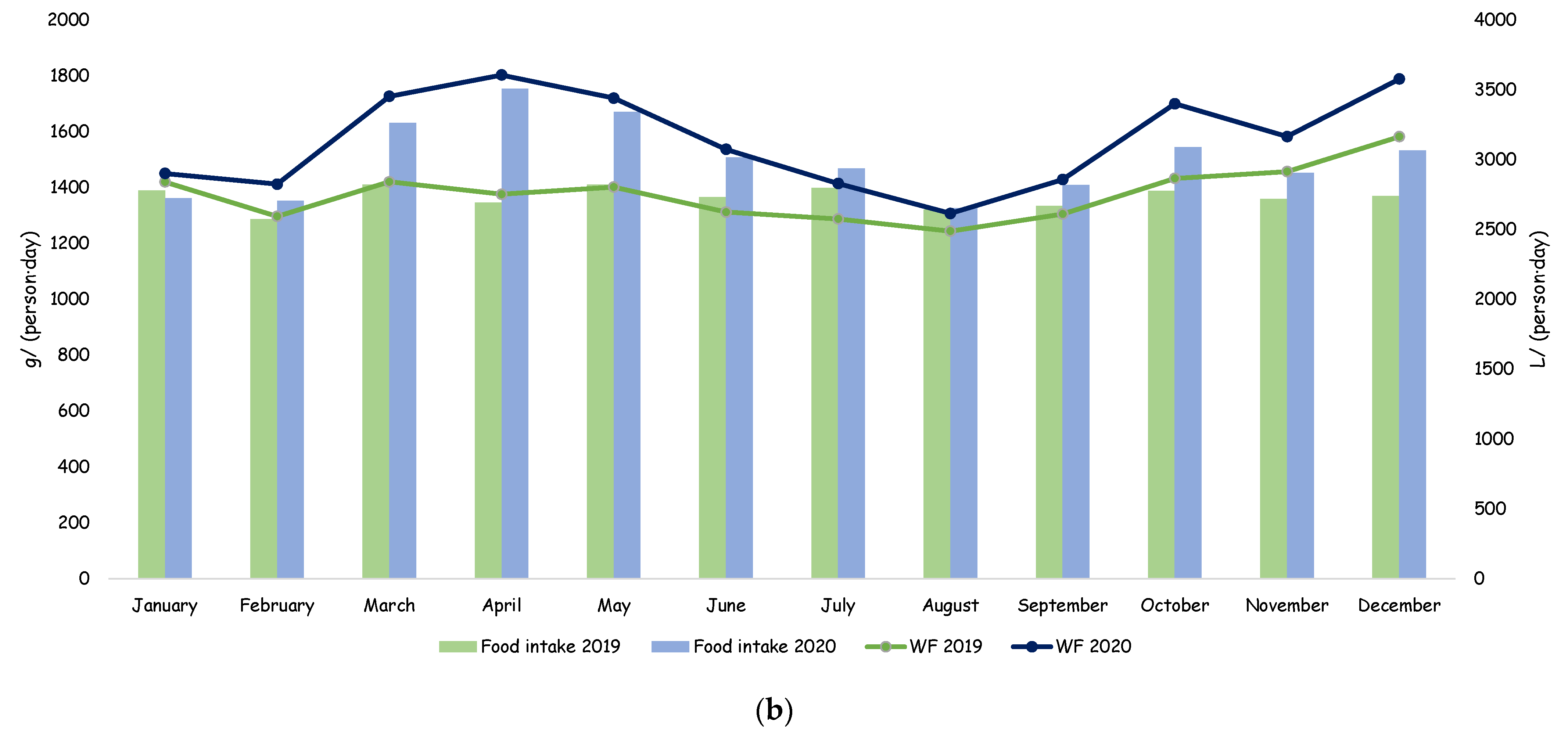
| Food Item | Spanish Dietary Pattern (g·person−1·day−1) | Food Item | Spanish Dietary Pattern (g·person−1·day−1) |
|---|---|---|---|
| Fruits | Dairy products | ||
| Oranges | 53.2 | Milk | 256.6 |
| Mandarin | 19.5 | Yogurt | 34.6 |
| Banana | 42.6 | Cheese | 29.5 |
| Apple | 33.5 | Butter | 1.5 |
| Pear | 16.1 | Total | 322.2 |
| Melon | 25.8 | Eggs | |
| Watermelon | 29.0 | Total | 26.7 |
| Lemon | 8.4 | Meat | |
| Peaches | 9.2 | Beef | 15.8 |
| Apricot | 2.6 | Chicken | 40.3 |
| Strawberry | 8.9 | Pork | 32.3 |
| Plum | 3.8 | Rabbit | 2.8 |
| Grapes | 7.3 | Sheep | 4.2 |
| Kiwi | 9.4 | Turkey | 4.5 |
| Pineapple | 6.3 | Processed meat | 36.6 |
| Mango | 2.9 | Total | 136.6 |
| Total | 278.4 | Fish and seafood | |
| Vegetables | Hake | 14.8 | |
| Tomatoes | 67.4 | Mackerel | 1.8 |
| Onions | 36.8 | Salmon | 9.2 |
| Peppers | 26.2 | Pilchard | 1.4 |
| Lettuce | 20.3 | Cod | 5.8 |
| Carrot | 18.4 | Tuna | 2.9 |
| Courgette | 21.0 | Trout | 1.4 |
| Cucumber | 10.4 | Sole | 3.7 |
| Cabbage | 8.0 | Bass | 4.3 |
| Garlic | 3.5 | Gilt-head bream | 4.5 |
| Mushroom | 7.0 | Turbot | 0.9 |
| Asparagus | 2.8 | Angler | 2.0 |
| Aubergines | 9.1 | Prawns | 11.2 |
| Artichokes | 6.3 | Squids | 8.4 |
| Leek | 5.2 | Mussels | 6.0 |
| Green peas | 1.2 | Clams | 3.0 |
| Total | 243.7 | Total | 81.3 |
| Pulses | Sweets | ||
| Chickpeas | 4.4 | Honey | 1.4 |
| Beans | 3.0 | Sugar | 11.9 |
| Lentils | 3.2 | Ice cream | 12.3 |
| Total | 10.7 | Chocolate | 13.2 |
| Starch-based products | Pastry | 20.4 | |
| Bread | 92.5 | Biscuits | 18.2 |
| Rice | 12.0 | Cereals | 5.7 |
| Pasta | 12.8 | Total | 83.3 |
| Potatoes | 90.7 | Oils and fats | |
| Total | 208.0 | Sunflower oil | 10.3 |
| Nuts | Olive oil | 22.9 | |
| Olives | 11.6 | Margarine | 1.8 |
| Almonds | 1.1 | Total | 35.1 |
| Walnut | 2.8 | Ready meals | |
| Peanut | 1.5 | Pizza | 10.2 |
| Hazelnut | 0.3 | Soups and creams | 24.0 |
| Pistachio | 0.9 | Sauces | 11.9 |
| Chestnut | 0.0 | Total | 46.2 |
| Total | 18.3 | ||
Disclaimer/Publisher’s Note: The statements, opinions and data contained in all publications are solely those of the individual author(s) and contributor(s) and not of MDPI and/or the editor(s). MDPI and/or the editor(s) disclaim responsibility for any injury to people or property resulting from any ideas, methods, instructions or products referred to in the content. |
© 2023 by the authors. Licensee MDPI, Basel, Switzerland. This article is an open access article distributed under the terms and conditions of the Creative Commons Attribution (CC BY) license (https://creativecommons.org/licenses/by/4.0/).
Share and Cite
Cambeses-Franco, C.; Urdaneta, H.J.; Feijoo, G.; Moreira, M.T.; González-García, S. Climate Change and Water Scarcity at the Focus of Environmental Impacts Associated with the COVID-19 Crisis in Spain. Sustainability 2023, 15, 11001. https://doi.org/10.3390/su151411001
Cambeses-Franco C, Urdaneta HJ, Feijoo G, Moreira MT, González-García S. Climate Change and Water Scarcity at the Focus of Environmental Impacts Associated with the COVID-19 Crisis in Spain. Sustainability. 2023; 15(14):11001. https://doi.org/10.3390/su151411001
Chicago/Turabian StyleCambeses-Franco, Cristina, Humberto José Urdaneta, Gumersindo Feijoo, María Teresa Moreira, and Sara González-García. 2023. "Climate Change and Water Scarcity at the Focus of Environmental Impacts Associated with the COVID-19 Crisis in Spain" Sustainability 15, no. 14: 11001. https://doi.org/10.3390/su151411001
APA StyleCambeses-Franco, C., Urdaneta, H. J., Feijoo, G., Moreira, M. T., & González-García, S. (2023). Climate Change and Water Scarcity at the Focus of Environmental Impacts Associated with the COVID-19 Crisis in Spain. Sustainability, 15(14), 11001. https://doi.org/10.3390/su151411001










